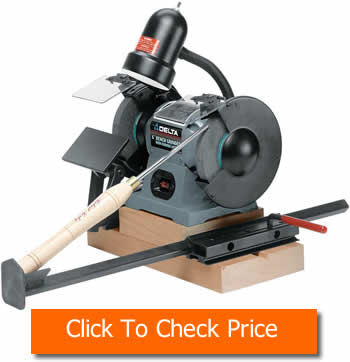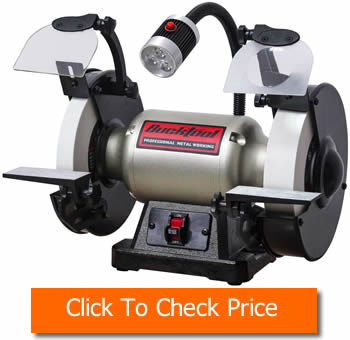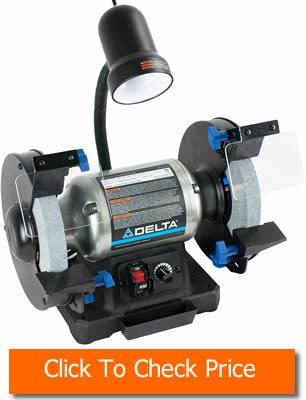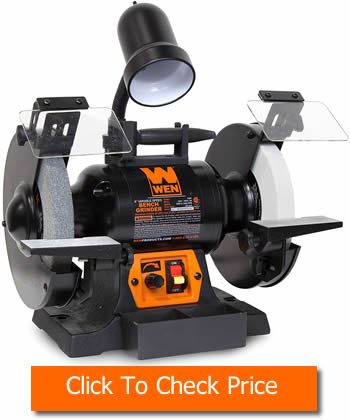Last Updated on 2021-06-17 by Harry Masterton


As a DIYer or woodworker, there might be some power tools you have neglected to explore. One of the most overlooked tools by those building up their shop is the bench grinder. That is unfortunate, as this power tool increases your ability to work with various materials and allows you to create or maintain an edge on your cutting tools.
There are many bench grinder designs available on today's market, but the variable speed bench grinder is the best choice. That does not mean that they are all equal, and you need to understand what features will make the best variable speed bench grinder for your needs.
The Best Variable Speed bench Grinder
DIYers will find that a benchtop grinder can use various wheels to cut, shape, or smooth out hard materials like metal. Speed adjustments will allow you to run at the proper speed for the wheel's material, preventing needless wearing or damage.
Running at a faster or slower speed might also be beneficial when working with soft or hard materials.
DIYers and woodworkers will find that a variable speed grinder can save them money over time by keeping tool edges sharp. That includes blades that can be expensive to resharpen or replace. Even brand new chisels from the store can benefit from sharpening on a grinder.
It also means that you don't have to buy a slow speed bench grinder just for sharpening tools.
The best variable speed bench grinder will have other features that benefit users. You might find that a variable speed grinder can improve your workflow, project scope, tool safety, and speed while adding an element of fun to your woodworking hobby.
Do I need A Variable Speed Bench Grinder?
The best variable speed bench grinder you can find will not offer any value to your shop unless you use it. If you are a casual woodworker or DIY-enthusiast with no time or desire to sharpen cutting tools, buying a variable-speed bench grinder might not make much sense.
If you are asking, “Do I need a variable speed bench grinder,” but only work with wood, it could be hard to justify its purchase. Outside of those scenarios, the best variable speed grinder designs can serve any shop.
You might wonder if a single-speed grinder would be better. There are several benefits that a variable speed grinder provides over a one-speed bench grinder:
- Operating comfort
- Improved safety
- Speed matching
- Greater selection
A variable speed bench grinder allows you to operate at a comfortable speed setting. Many jobs do not require the higher speed setting to complete, giving you the option to turn down the RPMs while you work.
The best variable speed bench grinder benefit could be improved safety. The wheels used on bench grinders come in different materials and suggested rates for specific RPMs. These bench grinders allow you to adjust to the correct speed to prevent wheel damage, damage to your workpiece, and potential injury to yourself.
Also, speed matching allows each wheel to perform the intended task correctly. Proper speeds prevent damaged edges on your cuts or grinds, as well as gouges on faces that you might be smoothing out. The correct running speed will allow the wheel to cut, grind, or polish without burning or melting your project as well.
The more variable your settings, the more you can match your bench grinder to the wheel selected. A Low/Medium/High-speed unit provides three positions, but that may not cover all your needs.
A variable-speed motor adjusts through a range of speeds and not just a few settings. I would say “yes” to almost anyone who asked, “Do I need a variable speed bench grinder?” That includes those who do not have a dedicated shop space.
Bench Grinder Uses
Grinders have been used for years by DIYers and home shops for several applications. The best variable speed bench grinder designs are used for:
- Buffing
- Cutting
- Grinding
- Removing
- Shaping
- Sharpening
Specialized wheels allow you to buff your workpiece. That includes putting a shine on tool or project surfaces, as well as buffing out scratches on plastics. Buffing compounds combine with a buffing wheel for faster results.
You can use your bench grinder to cut workpieces. Metal rebar, pipes, and brackets cut into pieces on a grinding wheel. Plastics and woods can also be severed, but other power tools do that more effectively. As the name suggests, one of the top bench grinder uses is grinding surfaces.
Grinding wheels come in designs for various metals, including hard steels or soft aluminum. You can remove excess seams and material from edges, faces, or joints. Excess materials are not the only things a bench grinder can remove. Another popular bench grinder uses would be removing rust from metals.
High humidity and standing water can generate rust quickly. The low settings on a variable speed come in handy here, especially when saving tool edges or cleaning a surface for welding.
A bench grinder is an effective tool for shaping objects. You can create concave surfaces and rippling surfaces or edges on your workpiece. Plastics, metals, and woods are popular materials to shape with a grinding wheel.
Many shop owners, especially woodworkers, depend upon their variable speed bench grinder to create and maintain edges on their woodworking tools.
You can make wooden jigs that will hold your chisels, hand plane blades, or other tool edges at specific angles as you sharpen. Save yourself money by avoiding sharpening services or replacement, but you can also modify the cutting edge to a different angle.
How To Sharpen Tools With A Bench Grinder
Grinding Applications
 Older woodworkers, and those continuing the traditional hand tool tradition, are familiar with resharpening their tool edges. One of the best variable speed bench grinder uses is refreshing the business end of your woodworking chisel, hand plane blades, drill bit and your favorite lathe tool and in fact any cutting tool you have in the shop.
Older woodworkers, and those continuing the traditional hand tool tradition, are familiar with resharpening their tool edges. One of the best variable speed bench grinder uses is refreshing the business end of your woodworking chisel, hand plane blades, drill bit and your favorite lathe tool and in fact any cutting tool you have in the shop.
The metal used for these tools is hard enough to cut but soft enough to be ground. Tool collectors and hand tool aficionados use the Rockwell Scalea to classify the hardness of various metals used in tools.
Oneway Wolverine Grinding Jig
Many of these metals range between the high-C50s or low-C60s on the Rockwell scale. You can use sharpening stones, files, or sandpaper, but learning how to sharpen tools with a bench grinder will save you a lot of time.
It begins with heating your tools in the oven. Set the temperature to 350-degrees Fahrenheit and place the metal tools you plan to grind inside for two hours. The reason you do this is to prepare the metal for grinding, and this step helps to minimize cracking.
Remove the tools and allow them to cool to room temperature. Select a medium-hardness-rated bench grinder wheel (60-grit aluminum oxide is a good starting point). Get your eye and ear protection on, and you are ready to begin repairs using your new grinding machine.
Start by working mushroomed ends. That allows you to get a feel for the wheel and metals working together. Work the material down to the desired shape. Next, clean up blunted edges and chipped surfaces.
The best variable speed bench grinder designs provide plenty of access to the wheel surface for contact at any angle. Now you can focus on creating the cutting edge. A wooden guide works well to place the tool edge at the correct angle to the wheel, creating a beveled angle of exacting degrees.
When you learn how to sharpen tools with a bench grinder, do not forget to use a wire wheel to clean-up your tool's surfaces.
Look for features like a cast iron base with rubber foot fitted to help with vibration control, wheel guard, spark deflector,
adjustable eye shield and an adjustable tool rest. You should also make sure a grinder wheel is included in the initial purchase
6 vs 8 Bench Grinder?
When picking out the best variable speed bench grinder for your shop and its needs, you will need to decide between 6 vs 8 bench grinder models. Each size offers users a slightly different experience when grinding. Does size make a difference at the point of grind?
Yes, it can. You will find that the larger grinding wheels are easier to contact with the surface (making it the better choice between 6” or 8 inch bench grinder for lathe tools). The larger diameter of the grinding wheel on 8-inch models also reduces the amount of wear it receives.
It grinds faster with fewer rotations, which helps to extend the life of the wheel.
You will have to make fewer wheel changeouts, something to consider when comparing 6 vs 8 bench grinder designs. Manufacturers will include larger electric induction motors in the 8-inch variable speed bench grinders.
It rotates the larger grinding wheels more efficiently. The larger designs usually run at lower RPMs and produce less heat (another consideration between using a 6” or 8 inch bench grinder for lathe tools).
Larger power tools cost more money to make and use more materials to build, and the 8-inch bench grinder is no exception. It will cost you more than a 6-inch bench grinder will. The price difference may be critical for woodworkers on a tight budget, making the smaller 6-inch bench grinder more accessible.
Wheel size can influence the size of the item you can grind, which is why larger wheels are preferable between 6 or 8 inch bench grinder for lathe tools or large cutting blades.
The best variable speed bench grinder designs will not take up a lot of space, but the 8-inch models need a bit more clearance than the smaller bench grinder models. They can weigh twice as much as well.
Best 8-inch Variable Speed Bench Grinder With Light
BUCKTOOL Bucktool 8-Inch Variable Speed Bench Grinder
 When it comes to ease of operation, the Bucktool TDS-200C4HL provides users with just that. It has a two-speed adjustment, a low setting at 1,725 Rotations Per Minute, and a high speed at 3,450 RPMs. Novice grinders and woodworkers sharpening tool edges can get by with those speeds.
When it comes to ease of operation, the Bucktool TDS-200C4HL provides users with just that. It has a two-speed adjustment, a low setting at 1,725 Rotations Per Minute, and a high speed at 3,450 RPMs. Novice grinders and woodworkers sharpening tool edges can get by with those speeds.
A fast speed will allow you to cut or grind objects quickly. It will leave a rougher surface in some applications, but equipping the proper wheel type will go a long way towards eliminating that.
The slower speed is ideal for working on hand tools and cutting blades. Fewer RPMs create less heat build-up that can damage softer metals. You can work a tool edge or cutting blade for longer on the 8-inch wheel because more surface area also equates to less heat build-up.
A three-watt LED light sits between the wheels. It uses three separate LEDs and has its power switch located on the light's housing.
With its powerful 3.1 AMP electric motor and metal motor housing The Bucktool TDS-200C4HL is a very capable slow speed grinder which allows you full control over material removal. Motor speed is variable from 1725 to 3450 Revs Per Minute.
Delta 8 inch Variable Speed Bench Grinder
 Some Delta variable speed grinder reviews rate the Delta 23-197 as the best all-around 8-inch grinder. One reason is control location. The on/off switch, variable speed control, adjustment knobs, and light are all positioned between the two wheels.
Some Delta variable speed grinder reviews rate the Delta 23-197 as the best all-around 8-inch grinder. One reason is control location. The on/off switch, variable speed control, adjustment knobs, and light are all positioned between the two wheels.
A feature that stands out for grinders with some experience is the variable speed control. The knob does not have a couple of presets but dials RPMs in between 2,000 and 3.400. That offers more control for users that like to creep up on an optimum speed setting.
You will note the light mentioned in most Delta variable speed grinder reviews. It uses a gooseneck for positioning and a large aperture for light to flow.
That will allow you to focus the light on either wheel as you work, and it can also be moved out of the way if you are grinding a larger workpiece.
Wen 4280 5 amp 8 inch Variable Speed Bench Grinder with Work Light
 The Wen Bench Grinder is a great budget bench grinder. One feature that should stand out in any Wen 4280 review should be the tools rests. They are not complete wrap-around designs, but they offer more support than most standard tool rests.
The Wen Bench Grinder is a great budget bench grinder. One feature that should stand out in any Wen 4280 review should be the tools rests. They are not complete wrap-around designs, but they offer more support than most standard tool rests.
The control knobs that Wen uses are big and easy to use. A simple control knob turns from low RPMs to the left and higher RPMs to the right. It does not include lines for markings, so you will have to estimate your speed as you make adjustments.
Getting a feel for the speed controls does not take long, however. Most Wen 4280 review articles you read will mention the cast-iron base on this design. It does add weight and has mounting holes.
Wen also includes a work light that sits higher above the grinder than others, with its switch at the crest of the lamp.
Jet IBG-8VS Variable Speed Bench Grinder
Recommended for: Serious hobbyists and manufacturers will find this to be a good choice, especially if they want to keep things clean. The IBG-8VS is an eight-inch benchtop design from Jet that measures 23.5 x 8.25 x 9.5 inches and weighs about 66 pounds. Jet does offer a separate stand (Jet 578173DBG-Stand), but it is not included with your purchase.
Jet IBG-8VS – features
The Jet variable speed bench grinder uses a one horsepower induction motor to generate rotation on the wheels. It is a single-phase system that powers off of 120-volts.
It offers variable speeds through push-button controls at the front center console. You can see the RPM setting listed on the digital display above the keypad. It uses large shields to protect you from flying debris.

The Jet variable speed bench grinder has a braking system that brings the grinding wheels to a complete stop in 20-seconds. Dust collection at both wheels prevents dust from flying into the air, keeping your shop and lungs cleaner than other grinders.
The Jet IBG-9VS is a small industrial bench grinder grade power tool and should last you for years.
It includes 30 and 60-grit wheels. The tool rests are average size and require bolt tightening. That makes them less likely to move during use, though. Wen offers a two-year warranty on the IBG-8VS Benchtop Grinder.
Jet IBG-8VS – Things We Like
- You are provided with dust protection on both wheels. There are tubes at the bottom of each wheel that connect at a T-junction before exiting through a 2.5-inch outlet.
- It has a digital readout display and touch-button controls. These are sealed from dust and provide a clear RPM reading.
- A braking resistor is included with the IBG-8VS. The system brings the grinding wheel to a stop in under 20-seconds from power off.
Jet IBG-8VS – Not So Good
- The design is ideal for high-use environments, including manufacturing settings. That focus makes it overkill for DIYers or casual hobbyists using it on occasion.
- It has a higher price-tag than other benchtop grinders, including other 8-inch models.
The DeWalt Bench Grinder
The DEWALT DW756 6-Inch has an industrial grade cast iron base for heavier duty use while the DEWALT DW758 Bench Grinder with an 8-Inch wheel is a real industrial strength grinder machine
Diamond Wheel Dresser
What is a grinding wheel dresser? A grinding wheel dresser cleans the wheel up after prolonged use and will remove the surface that may be clogged up, grooved and out of true. The POWERTEC 71003 Diamond Wheel Dresser will bring things back into shape in no time. The POWERTEC 71003 Diamond Grinding Wheel Dresser is an excellent option at a really great price.
Don't Let The Wrong Tool Grind Things To A Stop
So before we wrap up let's just clarify the differences between the various types of grinders the bench top slow speed grinder is used primarily for sharpening tools in our woodworking shop.
The angle grinder on the other hand is used for rough work, cutting and material removal. The Die grinder is a smaller rotary tool used where precision is needed.
When it comes to the best variable speed bench grinder, size can matter.
While casual woodworkers and homeowners may find occasional use for a six-inch design, serious hobbyists and professionals will find that eight-inch variable speed grinders offer more grinding surfaces with less heat build-up.
More Great Bench Grinder Reviews? Check our complete rundown on The Best Bench Grinder For Woodworking and The Best Bench Grinder Reviews
That does not mean that you won't find uses for an eight-inch benchtop grinder in your shop if you are a beginner or intermediate woodworker.
You will find the lower settings on the best variable speed bench grinder models to be ideal for hand tools and cutting blade sharpening. It might also add to the fun you have in your shop!


Leave a Reply